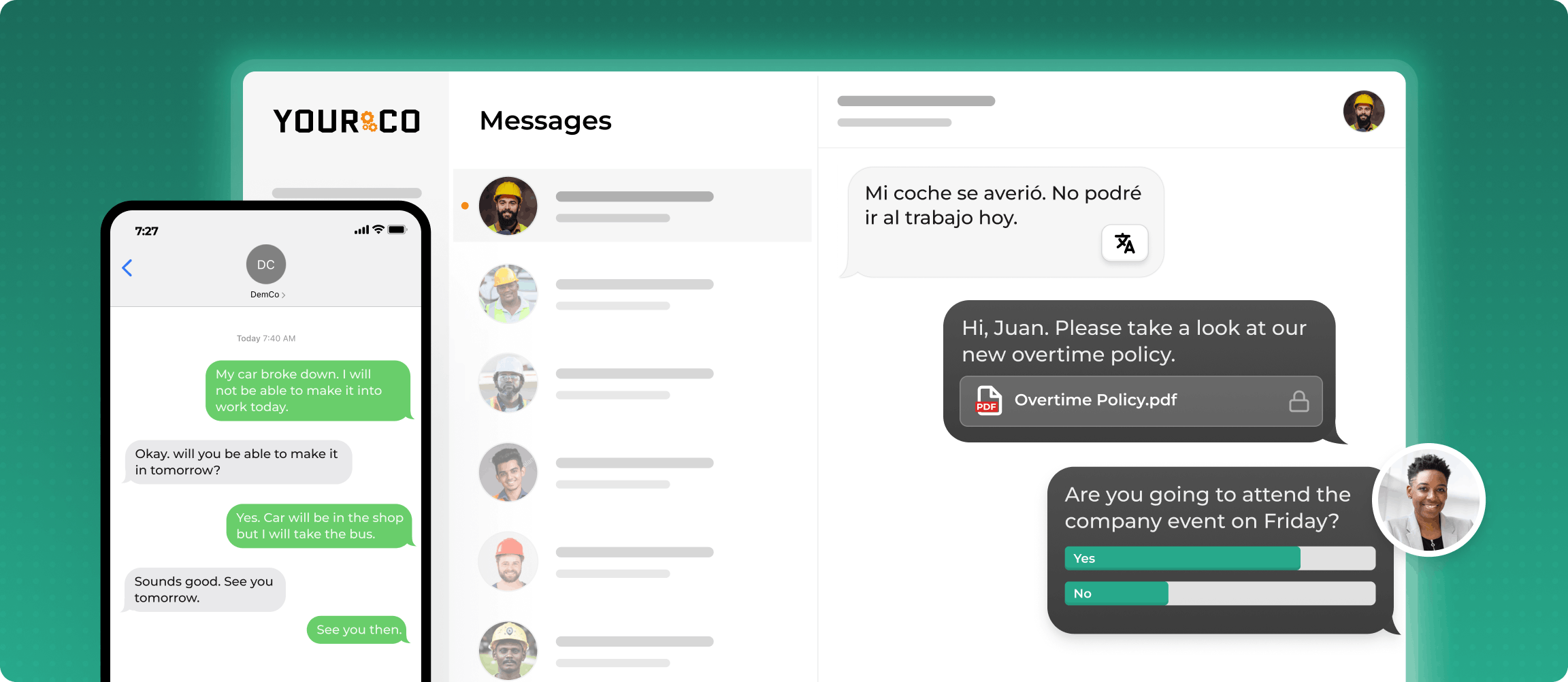Missing Counts, Staff Call-Offs, & Trashed Kitchens: How to Fix Multi-Site Restaurant Chaos


Planning restaurants on paper feels straightforward, but daily operations tell a different story. Inconsistent inventory counts, last-minute staffing gaps, and uneven workloads slowly eat away at your profits across multiple locations.
Each small issue (missing ingredients during lunch rush, equipment that never gets proper maintenance, staff who call out without coverage) creates a ripple effect that slows service and frustrates customers.
The solution lies in simple, practical fixes you can implement today: standardized checklists, instant text reminders, and real-time confirmations that keep every location aligned and running smoothly.
Stop Mid-Day Stockouts Across Locations
Inconsistent inventory routines quietly drain cash. When every location counts stock differently, small errors snowball into over-ordering, food waste, and lost sales you never see on the P&L.
You feel the pain when one store sits on excess produce while another 10 miles away runs out of a key menu item. Those gaps stem from irregular counts, paper logs that get misplaced, and no clear owner for the numbers. Such irregular counts lead to varying stock levels across sites, driving up carrying costs and shrinkage. Spoilage alone can push food cost percentages well above target, eroding already thin margins.
Standardizing the process fixes this fast. Implement these inventory management practices:
- Select fixed counting days (e.g., Tuesday before opening and Friday after closing) so that every manager starts inventory at the same time across all locations.
- Send automated text reminders like "Count dry storage now, reply DONE" to keep the task front of mind and create accountability.
- Require staff to add photos of count sheets or shelf snapshots to their replies, giving you proof in seconds.
- Connect replies to a shared dashboard where area managers can spot problems before they become stockouts.
With clear steps, automated reminders, and visual confirmation, your multi-site tracking turns from reactive scramble to smooth routine, saving cash and headaches at every location.
Streamline Product Movement and Fill Supply Chain Gaps
The moment you move products between locations without tight coordination, one wrong turn can wipe out a lunch rush.
When dough from the commissary shows up late or a driver forgets to scan a shipment, lines stretch, guests walk, and food waste climbs. Multi-site chains that rely on central kitchens or shared storage feel this pinch daily. Clear communication, not more trucks, fixes it.
Start by creating a simple movement playbook and pairing it with real-time updates. Key strategies include:
- Document who approves transfers, when trucks roll, and how much safety stock each store holds to eliminate confusion.
- Use restaurant supply chain management tools that send low-stock alerts the minute par levels dip.
- Pair alerts with simple text updates at every step, like "Van left Midtown at 10:15. ETA 10:40. Photo on arrival."
- Keep the receiving manager, prep lead, and driver informed in seconds through text-based communication that requires no app.
- Consider forecasting tools that predict when surging patio sales will empty the walk-in and trigger automatic transfer requests.
Until automated forecasting fully takes over, a clear protocol and text updates keep every location stocked, calm, and ready to serve.
Keep Kitchens Clean Without Constant Check-Ins
Consistency in cleanliness standards requires routine reminders that reach staff where they can see them quickly, and that’s on their phones. Depending on one dedicated employee or a weekly checklist posted on the wall invites missed spots and confusion when health inspectors arrive unexpectedly.
Start by setting up automated daily text schedules that clearly assign tasks. Text messages achieve roughly 95% open rates within three minutes, so staff won’t miss their assignments. Key tasks to automate include:
- Sanitizing prep tables at opening and closing to ensure clean surfaces for every shift and prevent cross-contamination risks.
- Wiping soda nozzles throughout the day to keep beverage stations hygienic and prevent sticky buildup that slows service.
- Checking restrooms hourly to maintain guest-facing standards and catch supply shortages before customers notice.
- Rotating responsibilities weekly to distribute workload fairly across the team and maintain morale.
- Adding small maintenance tasks, like changing fryer filters and tightening door seals, to the same text schedule.
Have employees send a quick photo once each task is complete. Timestamped images eliminate guesswork and provide clear documentation that you can review from any location. Since everything stays in the same message thread, you automatically build a compliance record without additional paperwork (valuable protection during food safety audits).
Fill Shifts Fast When Someone Calls Out
Tight wage caps and minimal staffing leave restaurant managers scrambling when someone calls out sick. A single absence on Friday night can derail your entire shift and blow through labor budgets.
Communication breakdowns make everything worse. Phone trees and email chains move too slowly when you need coverage now. By the time you reach everyone, overtime costs have already piled up. Tracking labor percentages only helps if you can react fast. Otherwise those numbers just confirm you overspent yesterday.
Move every staffing update to text messages and implement these proven tactics:
- Create a simple absence form via text that captures employee name, location, shift time, and reason so everything arrives in the same format.
- Fill gaps with mass alerts to qualified staff across nearby locations: "Need grill cook at South Street, 5-10 p.m. Reply YES to take it."
- Lock in coverage when the first "YES" arrives and stop the search.
- Send Thursday afternoon texts asking "All set for Saturday? Reply OK or HELP" to catch problems 48 hours early.
- Align with scheduling best practices that reduce the overtime issues workforce management experts flag as budget killers.
Standardize how staff report absences, how you broadcast open shifts, and when you verify upcoming schedules. Text communication replaces frantic phone calls with predictable workflows that keep locations staffed, labor costs controlled, and managers focused on service instead of scrambling for coverage.
Make Every Location Run the Same Way
Standardizing your playbook across sites speeds service, boosts safety, and makes training easier. Yet many chains still struggle with different grill layouts, unique labeling systems, and managers who coach their own way. These small differences slow new hires and create confusion for guests.
Build consistency through documentation and communication. Essential steps include:
- Write uniform standard operating procedures for every core task: prep, opening, closing, and stock management.
- House guides in the cloud and text a secure link to each shift lead, ensuring your message gets through where email often fails.
- Send weekly text updates with a short Friday recap highlighting menu tweaks or policy changes.
- Schedule Monday reminders to help teams focus on the week's priorities using department-specific lists (kitchen, bar, front of house).
- Use real-time dashboards to compare prep times, waste, and food-safety checks across stores, spotting outliers before bad habits spread.
If one location lags, send a quick text asking for a photo of the issue or confirmation that fixes are complete. Mass notification tools make that two-way follow-up simple and documented.
By pairing uniform procedures with fast, focused text communication, you create a playbook that travels with every employee, no matter which location they work.
Simplify Multi-Site Restaurant Operations with Yourco
Managing multiple restaurant locations means juggling countless moving pieces every day. Yourco gives you real-time visibility across every location through simple text communication that reaches every team member instantly.
When you need stock counts or cleaning confirmations, automated text reminders prompt each kitchen to respond with updates and photo proof. Every reply flows into one central dashboard, creating a clear compliance record you can access during audits. No missed tasks, no confusion about who did what.
Staffing gaps become manageable when a cook calls out sick. Send one message about the open shift to qualified staff, and the first person to reply "YES" gets booked. Messages automatically translate into more than 135 languages and dialects, so every employee understands exactly what's needed.
Yourco connects with 240+ HR and payroll systems, keeping your contact lists current while sending responses directly to the tools you and your employees already use.
Try Yourco for free today or schedule a demo and see the difference the right workplace communication solution can make in your company.
Frequently Asked Questions
How often should we count inventory when we run several restaurants?
Regular cycle counting works best at each site: daily spot-checks on high-value items and a full physical count every week or month. Pick the same day and time for each location, then log results digitally to keep numbers consistent and spot variances quickly. A playbook built on regular cycle counting prevents both overstock and surprise shortages.
Can text messaging really replace apps for staff communication?
Absolutely. Text messages reach every employee without forcing downloads, and they get read fast. Text messaging has near-immediate open rates of about 90% within three minutes, far higher than email or app notifications. That speed makes texting perfect for last-minute shift alerts, stock reminders, and safety updates across multiple sites.
What's the quickest way to move product between locations when one runs low?
Create a simple protocol: the manager who notices the shortage sends a text update to the designated transfer group, confirms pickup, and snaps a photo on delivery. Using mass notification platforms keeps every step visible, so you avoid duplicate runs and maintain accountability without extra paperwork.
How do we cut labor costs without hurting service quality?
Start by calculating each site's labor cost percentage daily. When the number creeps up, adjust schedules before overtime stacks, cross-train employees to cover multiple stations, and use text messaging to fill open shifts quickly. Smart scheduling trims wages while keeping enough hands on deck to protect the guest experience.




